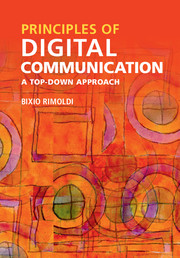Book contents
- Frontmatter
- Dedication
- Contents
- Preface
- Acknowledgments
- List of symbols
- List of abbreviations
- 1 Introduction and objectives
- 2 Receiver design for discrete-time observations: First layer
- 3 Receiver design for the continuous-time AWGN channel: Second layer
- 4 Signal design trade-offs
- 5 Symbol-by-symbol on a pulse train: Second layer revisited
- 6 Convolutional coding and Viterbi decoding: First layer revisited
- 7 Passband communication via up/down conversion: Third layer
- Reference
- Index
3 - Receiver design for the continuous-time AWGN channel: Second layer
Published online by Cambridge University Press: 05 January 2016
- Frontmatter
- Dedication
- Contents
- Preface
- Acknowledgments
- List of symbols
- List of abbreviations
- 1 Introduction and objectives
- 2 Receiver design for discrete-time observations: First layer
- 3 Receiver design for the continuous-time AWGN channel: Second layer
- 4 Signal design trade-offs
- 5 Symbol-by-symbol on a pulse train: Second layer revisited
- 6 Convolutional coding and Viterbi decoding: First layer revisited
- 7 Passband communication via up/down conversion: Third layer
- Reference
- Index
Summary
Introduction
In Chapter 2 we focused on the receiver for the discrete-time AWGN (additive white Gaussian noise) channel. In this chapter, we address the same problem for a channel model closer to reality, namely the continuous-time AWGN channel. Apart from the channel model, the assumptions and the goal are the same: We assume that the source statistic, the transmitter, and the channel are given to us and we seek to understand what the receiver has to do to minimize the error probability.We are also interested in the resulting error probability, but this follows from Chapter 2 with no extra work. The setup is shown in Figure 3.1.
The channel of Figure 3.1 captures the most important aspect of all realworld channels, namely the presence of additive noise. Owing to the central limit theorem, the assumption that the noise is Gaussian is often a very good one. In Section 3.6 we discuss additional channel properties that also affect the design and performance of a communication system.
EXAMPLE 3.1 A cable is a good example of a channel that can be modeled by the continuous-time AWGN channel. If the cable's frequency response cannot be considered as constant over the signal's bandwidth, then the cable's filtering effect also needs to be taken into consideration. We discuss this in Section 3.6. Another good example is the channel between the antenna of a geostationary satellite and the antenna of the corresponding Earth station. For the communication in either direction we can consider the model of Figure 3.1.
Although our primary focus is on the receiver, in this chapter we also gain valuable insight into the transmitter structure. First we need to introduce the notion of signal's energy and specify two mild technical restrictions that we impose on the signal set W = {w0(t), …, wm−1(t)}.
EXAMPLE 3.2 Suppose that wi(t) is the voltage feeding the antenna of a transmitter when H = i. An antenna has an internal impedance Z. A typical value for Z is 50 ohms. Assuming that Z is purely resistive, the current at the feeding point is wi(t)/Z, the instantaneous power is wi2 (t)/Z, and the energy transferred to the antenna is.
Information
- Type
- Chapter
- Information
- Principles of Digital CommunicationA Top-Down Approach, pp. 95 - 131Publisher: Cambridge University PressPrint publication year: 2016
